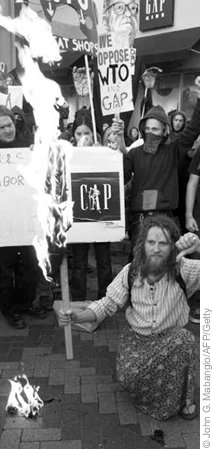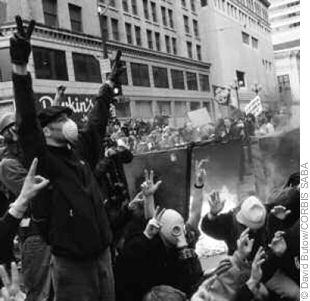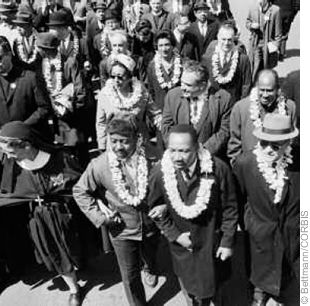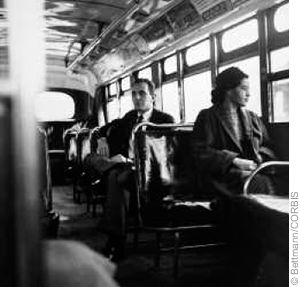
A new kind of civil disobedience came to Missoula, Montana, recently. On a bridge over the Clark Fork River, a group from Wild Rockies Earth First! blocked a truck carrying logs from the Bitterroot Forest. Two of the protesters tied ropes to the rig, lowered themselves and their sign, “Globalization Kills Our Forests,” to within a few feet of the torrent below, and refused to cooperate with rescuers who were dispatched from local fire stations to “rescue” them. The Earth Firsters were eventually coaxed to safety and charged with felony criminal endangerment. At their arraignment they denied that they had put the firefighters at risk, demanded to be set free, and ridiculed the conditions of their release on bail. One defendant brandished what a local newspaper called her “flame-and-monkey-wrench tattoos,” an emblem, apparently, of her willingness to wreck rather than to respect government.
Earth First’s brand of civil disobedience-frequently ill-tempered, not always nonviolent, and often coolly self-righteous-seems to be increasingly popular these days. Groups as diverse as ACT UP (gay rights), Critical Mass (environmental bicyclists), even the archconservative Catholic League are getting on the civil disobedience bandwagon. After the Ninth Circuit Court upheld a ban on “under God” in the Pledge of Allegiance in 2003, the League’s president wrote, “It is up to the teachers in the nine western states affected by this decision to break the law. They should instruct their students on the meaning of civil disobedience and then practice it.” Some of the new breed of lawbreakers lay claim to the traditions of civil disobedience. ACT UP, for instance, says its “fusion of organized mass struggle and nonviolence-originated largely with Mohandas Gandhi.” Appreciation of that past seems to be shockingly selective, however. Indeed, as even the Catholic League president insinuated, our schools, incubators of civic culture, play a significant role in instructing students about civil disobedience. But are American schools teaching the fundamentals of the social contract? Do our teachers appreciate that there is more to civil disobedience than mere self-expression or simple claims on conscience?
 |
| Many modern protests, like those against U.S. trade policy (above) feature anarchists, whose tactics are not always peaceful.
|
Not Your Father’s Disobedience
Traditional civil disobedience has usually combined deep spiritual beliefs with intense political ones. And while appreciating the differences in the two worlds-render unto Caesar what is Caesar’s and to God what is God’s-practitioners respected both. Gandhi, for instance, while leading a massive populist movement against British occupation of India (in the 1930s and 1940s), grew distrustful of mass demonstrations because participants were unwilling to go through the difficult process of purifying their actions; that is, grounding their activism in religious faith and human dignity. Martin Luther King, who warned that civil disobedience risked anarchy, went to jail “openly, lovingly, and with a willingness to accept the penalty.”
While sometimes willful and defiant and sometimes passive to the point of self-extinction (Socrates did not protest his punishment), the heroes of civil disobedience believed in the need to obey a higher authority and to be cleansed of self-interestedness. For instance, King’s words from an Alabama jail cell in 1963 (where he was being punished for marching in defiance of a court order): “A just law is a man-made code that squares with the moral law or the law of God. An unjust law is a human law that is not rooted in eternal law and natural law.” Compare those sentiments with the words written 40 years later by Craig Marshall, an Earth Liberation Front activist, from his Oregon jail cell (where he was serving a five-year term for setting fire to logging trucks): “There are necessary evils if we want to be effective in our struggles, such as the use of petro-fuels in igniting huge bonfires in which we can watch corporations go bankrupt. I hope I don’t sound as if I’m condemning these activities-by all means, burn the [expletive deleted] to the ground.”
Compare the reasoning of Gandhi and King, who presume harmony between a moral order and a rightly formed conscience, to the rationalizing of Earth First! and its political cousin the Earth Liberation Front (ELF). For Earth First! an ethic of “Deep Ecology” justifies “using all the tools in the tool box-ranging from grassroots organizing [to] monkey wrenching [which includes] ecotage, ecodefense, billboard bandits, desurveying, road reclamation, tree spiking.”
Similarly, the Earth Liberation Front argues that “dependence on the substances in the natural environment” justifies “more and more step[ping] outside of this societal law to enforce natural law” and boasts that since late 1997 “there have been over two dozen major actions performed by the ELF in North America alone resulting in nearly $40 million in damage.”
In many respects Martin Luther King would seem to have more in common with the Supreme Court, which dismissed his Birmingham appeal, than with modern protesters. “In fair administration of justice no man can be judge in his own case,” the Court wrote in 1967, “however exalted his station, however righteous his motives, and irrespective of his race, color, politics, or religion. Respect for judicial process is a small price to pay for the civilizing hand of law, which alone can give abiding meaning to constitutional freedom.”
 |
| During part of the famous Selma to Montgomery Freedom March in 1965, Martin Luther King and fellow civil rights leaders wore the Hawaiian necklace of flowers-the lei-to symbolize their peaceful intentions.
|
Then and Now-and Then Again
In 1972, when the United States was experiencing race riots, war protests, and campus violence, Harvard political scientist Edward C. Banfield penned an essay, “How Many, and Who, Should Be Set at Liberty?” describing an American society spinning out of control. Banfield sounded an alarm that should resonate for teachers, administrators, and curriculum committees today as they consider their civic education duties. Banfield quoted John Locke grouching about youth’s innate “inability to control impulses and to take the future into account.” He went on to warn that society would only prolong this adolescent predisposition if it instructed the individual “that he must be his own ultimate judge of what is right and wrong and that the -moral censure’ of anyone claiming authority over him is mere opinion.” Quoting another political philosopher, John Stuart Mill, Banfield notes that no society can reasonably expect a liberated individual to naturally “accept and act upon certain indispensable social rules,” and so society must transmit the wisdom and authority of “received opinion” to its young lest they remain mere children.
Unfortunately, contemporary social studies practice runs the risk of increasing, more than decreasing, the likelihood that students leave schools as mere children. Even aside from the question of whether schools are adequately exposing students to ideas of political theorists like Locke and Mill (much less to those of Plato, Jean-Jacques Rousseau, or Thomas Jefferson), the learning theory known as “constructivism” has encouraged the ahistorical trend. Now widely accepted among educators, constructivism has, inadvertently perhaps, undermined a sense of responsibility to the larger community by, as Diane Ravitch has observed, encouraging students to “construct their own knowledge through their own discoveries.”
When viewed simply as a student-centered methodology and poorly applied, constructivism can-and does-lead to inadequate teacher-led explanations of complex ideas like that of the “unjust law.” And by emphasizing that children are their own measure of things, teachers shirk their responsibility as subject-matter experts. Students with a faulty moral compass and nothing but half-baked opinions come away from the classroom thinking that laws are simply inconvenient obstacles to achieving personal goals.
 |
| In a well-considered exercise in civil disobedience, Rosa Parks recreates her historic December 1, 1955, protest against segregated busing in Montgomery, Alabama-this, on the day, December 21, 1956, the U.S. Supreme Court ruled that her 1955 arrest was illegal.
|
What’s Taught-What’s Not
In fact, there are civil disobedience lesson plans, but most are based on poorly applied constructivist theory. One developed by Gallaudet University, for instance, invites high school students to compare the Underground Railroad with some other act of civil disobedience in U.S. history, but offers no basic definition of the concept and instead simplistically asks students “when they might consider breaking the law because it is unjust.” Typical of these lesson plans, it is thin on substance, leaves the students to teach themselves about civil disobedience, and does not help teachers whose own knowledge of civil disobedience is weak.
Even the best of social studies materials can set students on the wrong track. A PBS lesson plan on civil disobedience, packaged with the video, “A Force More Powerful: A Century of Nonviolent Conflict,” says that Gandhi’s method of nonviolence had three parts: “identify an unjust law, refuse to obey it, and accept the consequences.” While more substantive than many such materials, the PBS lesson still leaves out the critical Gandhian step of self-purification. According to Gandhi, who was also known as Mahatma, or “Great Soul,” this is the time when practitioners must make a “total moral commitment,” that is, commit themselves to “a living faith in a living God” and not to a “useful political strategy in a specific situation.” This is no small matter in the civil disobedience tradition-and it could be considered a major omission from the PBS lesson. King, too, urged his followers to steel themselves to passive nonviolence in the manner of Jesus Christ. For Gandhi and King, law-breaking is justified only when it respects authority and recognizes the opponent’s human dignity.
Another PBS lesson plan on civil disobedience asks students to identify “issues of concern” (such as school uniforms or a tax exemption for a business that pollutes), “brainstorm different ways people make their opinions known about issues of concern,” “discuss which of these methods are acceptable’ means of protest to them,” and “identify possible negative consequences of activism to individuals engaged in these activities.” Missing from the plan is a definition of civil disobedience or mention of the four essential components of civil disobedience-or even the three components that they had identified in the earlier lesson. Nor does the lesson discuss the difference between a fundamental principle and a personal desire or between legal protest, civil disobedience, and purely criminal activity, much less the threats that each poses to a democratic society. In these and other lessons, the teacher is directed to place the burden on the student to “construct” his or her own understanding of civil disobedience-a notion that contradicts the beliefs of the most profound protesters.
In matters of civil disobedience such constructivism only pushes students toward a naive belief in the primacy of conscience (which can easily become a synonym for self-centeredness). Even the Center for Civic Education, a 40-year-old nonprofit organization whose National Advisory Committee reads like a Who’s Who of democratic values and traditions (including a dozen current and former members of Congress and a couple of Supreme Court justices), does not explain in its curriculum standards that civil disobedience is rooted in fundamental principles as opposed to personal preferences.
A Defective Canon
It is not surprising, then, that history and government textbooks, increasingly shaped by loose standards, incomplete assessments, and a generation of constructivist pedagogy, poorly serve the teacher’s critical need for solid information about civil disobedience. Many U.S. history textbooks make only superficial mention of civil disobedience, generally in relation to the modern civil-rights movement. One widely used 8th-grade text, American Odyssey, by Gary Nash, contends that King followed the “Gandhian strategy of nonviolence-investigation, negotiation, publicity, and demonstration,” but omits mention of self-purification and the need to accept the consequences of one’s actions.
Twelfth-grade American government texts, where a political theory perspective is expected, routinely say almost nothing about civil disobedience. The Center for Civic Education’s secondary-level We the People ignores the acceptance of consequences in its answer to the question, “Must you obey bad rules?” Another senior government text (American Government, by Steven Kelman) implies that all peaceful protest is legal protest and describes King’s nonviolent activities without explaining civil disobedience. Though these texts do not specifically condone civil disobedience, neither do they encourage students to consider the wisdom of the past while making their own judgments.
To provide some perspective on the question of what is not taught in most civics texts, we look at American Civics by William Hartley and William Vincent. They provide one of the more succinct definitions of civil disobedience offered to high schoolers: “The right of all Americans to express their dissent against laws in these and many other ways is protected by the Constitution. People do not have the right, however, to break the laws while expressing their dissent. During the civil-rights movement, and at other times in the past, some Americans have shown their dissent by intentionally disobeying laws they believed to be wrong. This practice is called civil disobedience. As you know, people who disobey a law must face the consequences.” This kind of treatment is needed for students who should be wrestling with fundamental concepts of government rather than their personal feelings about it.
Do as I Say-Or as I Do?
A student’s inclination to cross the line of legality under the guise of self-expression can also be abetted by imprudent teachers. According to a 2003 report in a Maryland newspaper, a local high school English teacher, as part of a lesson on Henry David Thoreau, urged his students to perform a “nonconformist act.” Two young women were suspended from school after they stood on top of a cafeteria table, staged a long kiss, and shouted “End homophobia now!” What lessons the teacher drew from this event we do not know. But such pedagogy merely trivializes civil disobedience and panders to students’ desires to be outrageous and to make adults uncomfortable.
A Kentucky high school teacher took negative role modeling further, getting convicted for trespassing on the U.S. government’s Western Hemisphere Institute for Security Cooperation at Fort Benning, Georgia, and then fired for missing class while serving her 90-day jail sentence. While she complained, according to Education Week, that the school district should have granted her a leave of absence, a letter writer to the newspaper reminded the teacher of her history: “While civil disobedience and legal protest have long been used as ways of attracting attention to a cause, civil disobedience is unique because it has always carried with it the obvious risk of arrest and possible imprisonment.”
Though the trespassing teacher is surely an anomaly, her apparent failure to appreciate the important nuances in balancing liberty and authority is an all-too-common failing of the new civil disobedience. Coming to the correct balance means neither empowering political majorities to regulate liberty in new ways nor excusing individuals from the consequences of their actions. Getting the balance right means thwarting the present trend toward teaching the tenets of personal autonomy and ignoring the history that has already taught us much about the need for-and limits of-legitimate government. The forces that shape civics education-teachers, standards, methods, and materials-have important roles to play. But they must state clearly that civil disobedience differs from peaceful and legal protest; that civil disobedience involves violating a law that a rightly formed conscience determines to be in conflict with a fundamental principle of human dignity; and that civil disobedience is circumscribed by the practitioner’s obligation to honor legitimate government by accepting punishment openly and respectfully. Without this tilt toward authority and away from anarchy, individual liberty will be endangered.
James J. Lopach is a professor in the department of political science at the University of Montana, where he teaches American government and public law.
Jean A. Luckowski is a professor in the department of curriculum and instruction at the University of Montana, where she teaches social studies methods and professional ethics.
This article was funded by a grant from the John Templeton Foundation.


